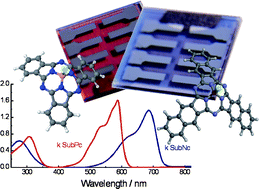Chloroboron (III) subnaphthalocyanine (SubNc) films have been characterized by ellipsometry, absorption, photoluminescence measurements, and atomic force microscopy. The films strongly absorb red light, as the extinction coefficient k peaks at 1.4 at a wavelength of 686 nm. Planar bilayer heterojunctions with fullerene (C60) on top of SubNc are measured under AM 1.5 simulated illumination at various light intensities, leading to an open-circuit voltage (Voc) of 790 mV and a power conversion efficiency of 2.5%. The external and internal quantum efficiencies peaked at 36% and 70%, respectively. The combination of a strong red absorption and high Voc make SubNc an interesting material for organic solar cells, in particular for tandem cells.
You have access to this article
 Please wait while we load your content...
Something went wrong. Try again?
Please wait while we load your content...
Something went wrong. Try again?


 Please wait while we load your content...
Please wait while we load your content...